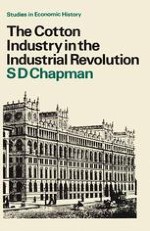1972 | OriginalPaper | Chapter
The Role of Cotton in the Growth of the Economy
Author : S. D. Chapman
Published in: The Cotton Industry in the Industrial Revolution
Publisher: Palgrave Macmillan UK
Included in: Professional Book Archive
Activate our intelligent search to find suitable subject content or patents.
Select sections of text to find matching patents with Artificial Intelligence. powered by
Select sections of text to find additional relevant content using AI-assisted search. powered by
THE period between about 1450 and 1750 saw relatively few mechanical inventions introduced into the European textile industries; the stocking frame at the end of the sixteenth century and the Dutch loom in the seventeenth appear to be the only conspicuous exceptions to this generalisation. The great burst of invention that began with Arkwright and Crompton has some roots reaching down earlier in the century, but the desultory reception of Kay’s flying shuttle and Lewis Paul’s roller spinning in the 1730s and 1740s occurred in a different economic climate from the last thirty years of the century. Most of the explanations that are offered on the causes of this unprecedented period of technical development have been familiar to historians for a long time: a chronic shortage of yarn and steeply rising costs as weavers adopting the flying shuttle had to draw their yarn supplies from domestic spinners further and further away; the physical qualities of cotton, which make it peculiarly amenable to mechanical handling; and the high elasticity of supply of raw cotton from the rapidly growing United States.
